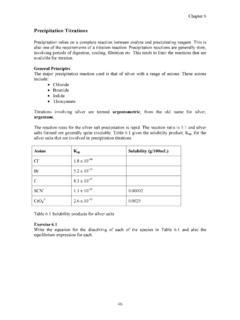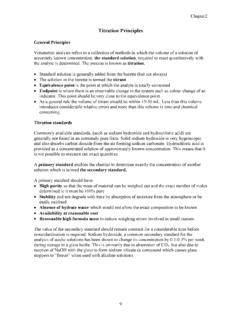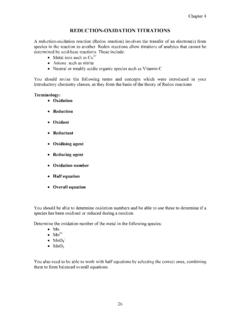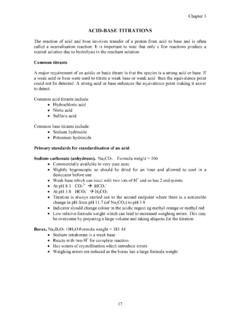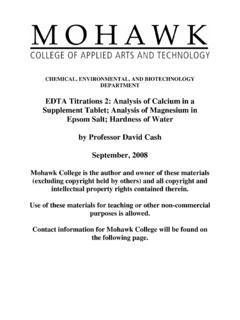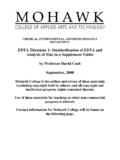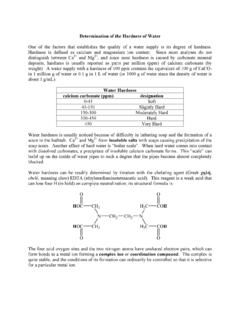Transcription of Complexometric Titrations - cffet.net
1 Chapter 5. Complexometric Titrations Complexometric Titrations are based on the formation of a soluble complex upon the reaction of the species titrated with the titrant. M + L ML. In the module Chemistry 2 you were introduced to the basic terms and concepts of metal complexes. Use the next section as revision of these terms and concepts. Components of a complex: Metal ion Ligand Multidentate ligands Chelate rings How a complex forms: Type of bonding Multi-step formation Factors affecting the complex formation: Size and charge of metal ion Number of bonding sites on the ligand 36. Chapter 5. Formation or stability constants Meaning Significance Complex Formation in Titrations For the titration of metal ions, the reaction with the ligand must be: Rapid Formation constant sufficiently large to meet the completion requirement.
2 With monodentate ligands such as ammonia, the overall formation constant is high but the reaction is stepwise ie the individual reaction formation constants are low. There is a gradual change in the metal-ion concentration which is not desirable for a titration. With ligands that form 1:1 complexes with the metal ion, the change in metal concentration is dramatic at the equivalence point. Fig shows this, with pM representing the negative log of [M]. A ligand such as EDTA shows this type of dramatic change. Fig Titration curves for complexation reactions with mono- (A); bi- (B) and Tetradentate- (C) ligands (from Skoog , West & Holler, Fundamentals of Analytical Chemistry p259). 37. Chapter 5. Ethylene diamine tetraacetic acid. Fig EDTA. EDTA is widely used in analytical chemistry as a titrant. EDTA: has six potential bonding sites, identified in Fig will only form a 1:1 complex with metal ions (regardless of their charge or size).
3 Metal-EDTA complexes are generally quite stable, due to the number of chelate rings formed (see Fig ). Fig Structure of a metal-EDTA complex Forms complexes with almost all metals Formation constants vary depending on the metal ion as shown in Table Cation Log KF Cation Log KF Cation Log KF. Na+ Mn2+ Zn2+ Ag+ Fe2+ Pb2+ Mg2+ Co2+ Hg2+ Ca2+ Ni2+ Al3+ Ba2+ Cu2+ Fe3+ 38. Chapter 5. Compare the formation complex for the sodium-EDTA complex and the iron (III) EDTA complex. As the formation complex for sodium and the other group 1 metals is very low the reaction is not suitable for titration. EDTA is usually used to titrate Main Groups 2-4 and the transition metals, where formation constants are higher. Describe the trend in formation constants in relation to the charge on the ion. EDTA is a molecule with four weakly acidic hydrogens attached to each of the acetic acid ends.
4 The structure of the ligand is therefore pH dependent. Fig shows the distribution of four possible protonated forms of EDTA across a wide range of pH. 39. Chapter 5. What are the predominant forms of EDTA at the following pH's 5. 8. 12. At pH 5 the formation of a complex between EDTA and a metal ion is given by the equation Mn+ + H2Y2- MY(n-4)- + 2 H+. The equilibrium reaction is affected by: *. *. *. As acidity increases the equilibrium moves to the left, affecting the stability of the complex. At low pH's the stability of the complex is low and there is much competition between the metal ion and the H+ for the EDTA. The lower the stability of the relevant metal-EDTA complex, the higher the pH must be maintained during the titration. ie the solution must be buffered. What would be the problem of titrating without a buffer, a reaction between a metal and an EDTA solution.
5 The titration of calcium and magnesium ions with EDTA must be maintained at pH =10, since the formation constants for the complexes with these metals are relatively low. For more stable complexes, such as the iron (III) EDTA complex titration can be done at much lower pH. pH control provides some selectivity for EDTA Titrations . Fig highlights the dependency of pH control. 40. Chapter 5. Fig Minimum pH required for satisfactory titration with EDTA. EDTA is available in primary standard form but it is relatively insoluble. Use of the disodium salt standardised against a solution of calcium, magnesium or zinc ions obtained from a pure metal salt such as calcium carbonate. Endpoint detection Metallochromic indicators are now used for endpoint detection. Coloured organic compounds which form complexes with metal ions.
6 Free indicator must have a different colour to the chelate (indicator/metal ion complex). Work by combining with excess metal ion and releasing when excess EDTA is present Indicator must release the metal ion to the EDTA as close as possible to the endpoint ie the indicator metal ion chelate must be less stable than the EDTA/metal/ion chelate 41. Chapter 5. Erichrome Black T (EBT). Useful in any titration were pH range is between 7 and 10, including calcium, magnesium and zinc EBT is triprotic and has a different structure at varying pH values Between pH 7 and 10 it exists as the dianion (Hin2-) and is blue in colour It forms a red-purple complex with metals Fig Structure of EBT. When used with only calcium present an error is caused as the CaEBT complex is relatively unstable, releasing the indicator prior to the endpoint.
7 Small amount of Mg-EBTA complex is added to overcome this error as the Mg-EBT. complex is much more stable and releases at the endpoint. Common metallochromic indicators Indicator pH range Colour change Applications (complexed to free). Erichrome Black T Alkaline Red to blue Many metals Calagmite Alkaline Red to blue Better than EBT. Xylenol Orange Acid/neutral Red to yellow Zn, Sn, Pb Methylthymol Blue Very alkaline Blue to yellow Ca, Sr Table metallochromic indicators Specificity in EDTA Titrations Due to the large number of reactions possible with EDTA specificity for a particular metal ion is difficult. Sample treatment is required before reliable Titrations are possible. Treatments include: Addition of masking agents which specifically bind the interference. Addition of a releasing agent after the initial titration and then further titration to determine the amount of released EDTA.
8 42. Chapter 5. Masking is the exclusion of the action of an interfering substance by the addition of an appropriate reagent and without removal of the substance. It can be achieved by 1. pH control: some interferences can be removed by lowering the pH of the solution to a point where the reaction with EDTA is negligible eg titration of Fe3+ (with high formation constant) is possible without interference from Ca2+ (low stability constant). at low pH. 2. Precipitation: interferent can be removed by precipitation eg precipitation of magnesium as the hydroxide at pH 12 leaves only the calcium for titration. Problems of coprecipitation may occur 3. Change in oxidation state: many metals behave differently in different oxidation states eg complexes of EDTA with Fe (II) are significantly less stable than iron (III) so masking of iron interferences could be achieved by reducing the iron (III) to iron (II).
9 With ascorbic acid and lowering the pH. 4. Complexation: use of another complexing agent in the reaction, which forms a more stable complex with the interferent than does EDTA. This prevents the interfering species reacting with EDTA. Table Ligands used as masking agents Masking Agent Interferences Cyanide Zn, Cd, Cu, Ni, Co Fluoride Fe, Al, Ca, Mg Phosphate Ti Iodide Hg(II). Citrate U, Al Diethyldithiocarbamate Pb, Cd, Cu Sulfide Heavy metals Thiosulfate Ag Demasking: involves the titration of all reactive species with EDTA, followed by addition of a reagent which will release one metal species from its EDTA complex. The freed EDTA is then titrated providing a measure of the amount of that one species. Analysis of a mixture of tin and lead. Mixture complexed with EDTA followed by complexation with fluoride ion which releases the EDTA from the tin complex.
10 Zinc in the presence of copper also involves demasking. Each has similar formation constants and will complex with EDTA at pH 10. Before titration, cyanide is added, complexing both metals. Methanal is then added, which damasks the zinc, freeing it to be titrated with EDTA. 43. Chapter 5. Some common Applications Water Hardness Determination of Ca and Mg in water provides a measure of the hardness of water. Hardness in water causes normal soaps to fail to lather, causes scaling in boilers clogging pipes. Titration is done at pH 10 where calcium and magnesium are titrated, with EBT (or Calagmite). The result is reported as calcium carbonate. Aluminium Uses a back titration method as aluminium reacts very slowly with EDTA. A known excess amount of EDTA is added to the aluminium solution, the sample heated and then the excess EDTA titrated with a standard solution of magnesium, calcium or zinc.
